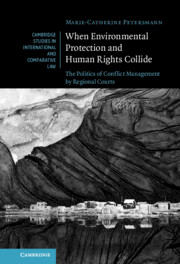 When Environmental Protection and Human Rights Collide
When Environmental Protection and Human Rights Collide Published online by Cambridge University Press: 20 October 2022
This introduction lays out the context, scope, theoretical framework, core arguments and structure of the study. It problematises the focus on synergies between environmental protection and human rights in existing literature, and emphasises the importance of retrieving, exploring and critically unpacking the conflicts that underpin this relationship. The analysis introduces the central interrogation of the book: how environmental protection laws can collide with human rights concerns, and how regional human rights courts balance individual or collective human rights against the interest in environmental protection, when environmental protection and human rights collide. Several sub-questions unfold from this main interrogation. How do regional human rights courts address, conceive of and frame conflicts with environmental laws, many of which include considerations that are part and parcel of existing human rights? Which conflict-management techniques and argumentative strategies do they employ to settle such trade-offs? And what does this tell us about how the environment is represented, and how its protection is legally justified in relation to human concerns? The summary of the main findings of the book lay bare the importance of the project, the gaps it aims to fill, and how these novel insights reconfigure the relationship between environmental protection and human rights.
To save this book to your Kindle, first ensure no-reply@cambridge.org is added to your Approved Personal Document E-mail List under your Personal Document Settings on the Manage Your Content and Devices page of your Amazon account. Then enter the ‘name’ part of your Kindle email address below. Find out more about saving to your Kindle.
Note you can select to save to either the @free.kindle.com or @kindle.com variations. ‘@free.kindle.com’ emails are free but can only be saved to your device when it is connected to wi-fi. ‘@kindle.com’ emails can be delivered even when you are not connected to wi-fi, but note that service fees apply.
Find out more about the Kindle Personal Document Service.
To save content items to your account, please confirm that you agree to abide by our usage policies. If this is the first time you use this feature, you will be asked to authorise Cambridge Core to connect with your account. Find out more about saving content to Dropbox.
To save content items to your account, please confirm that you agree to abide by our usage policies. If this is the first time you use this feature, you will be asked to authorise Cambridge Core to connect with your account. Find out more about saving content to Google Drive.